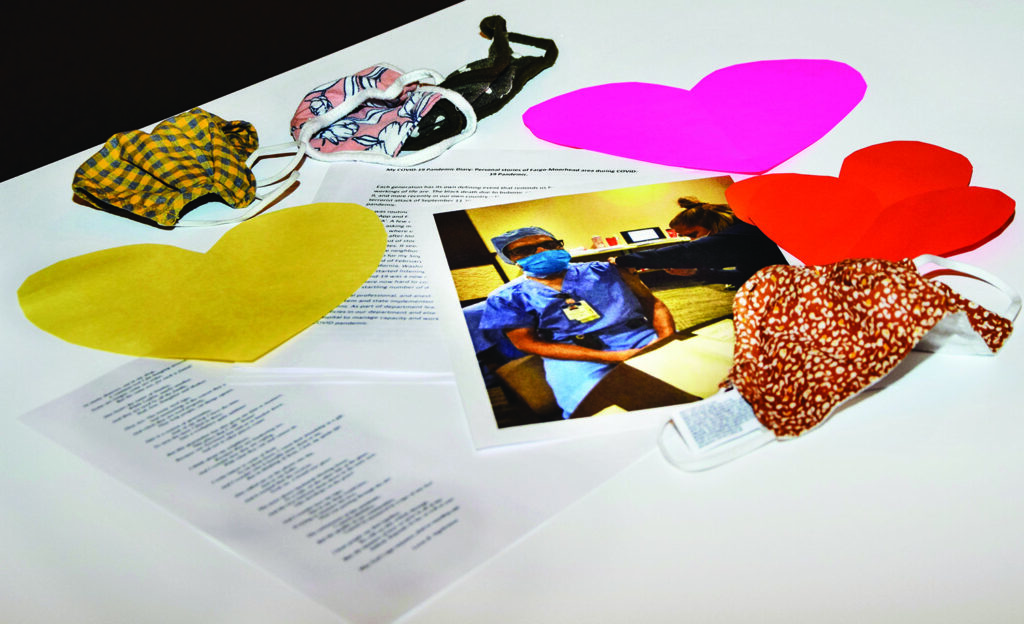
The historians are collecting written accounts, photos and artifacts of the COVID pandemic, including these face masks and colored paper hearts families displayed in their windows.
Nancy Edmonds Hanson
Only a few years ago, the historians of Clay County were sifting their collection for century-old evidence of the greatest pandemic in the country’s history. Now they find themselves capturing echoes – grabbing memories and artifacts of another worldwide pandemic that their counterparts will someday study and interpret themselves.
History is being made right now on the fly, and the Historical and Cultural Society of Clay County has made it its mission to chronicle it. “We’re looking for memories that are being made right now,” says Markus Krueger, program director for the history unit headquartered in Moorhead’s Hjemkomst Center. That archive has already begun to grow, with photographs, homemade masks and construction-paper hearts families plastered on their front windows as the pandemic emerged last March. Too, the historians welcome written reflections, from the poetry of a faithful supporter in Felton to the detailed account of the medical crisis prepared by board president Vijay Gaba, M.D., who has been in the thick of it.
But as the COVID crisis approaches its first 12-month anniversary, Markus and his colleagues hope for much more. “Maybe someone can share a certain mask with the story behind it, or tell us about their family’s experience with virtual schooling at home,” he muses. “Things that seem commonplace today can carry significance and meaning someday for generations who have not lived through this.”
He suggests that whoever has a tale to tell or an artifact to share contact any member of the HCSCC staff to talk it over.
Markus and his colleagues have some insight into what historians of the future will long to see. In recent years, they scoured their own collection for material for the major exhibit “War, Flu and Fear” that drew visitors to the main gallery from 2018 through last November. The exhibition about Clay County’s experience with World War I and the concurrent worldwide Spanish Flu epidemic faced a couple of challenges during its heralded but foreshortened showing: Not only did the pandemic itself take place 15 years before the historical society was even founded … the governor’s emergency measures to contain COVID-19 in 2020 cut visitors to a trickle and then eliminated them entirely.
The exhibition was originally slated to run through February. But in November, when the second shut-down of museums and other public venues locked the doors in November, the staff decided to call it quits. They took down the exhibit materials and stored them away. When the doors open again Monday, Feb. 1, visitors can view a new display featuring photographs taken by Farm Security Administration photographer Russell Lee.
In 1937 – about the same time HCSCC was getting off the ground – Lee spent months in Polk County and the surrounding area photographing the nascent sugarbeet industry. His photos depict the fields, the farmers and the migrant families who laid the groundwork for the region’s booming sugar industry today. The photos will be on display through March 14; the exhibition has been organized by Ken Mendez of the University of Crookston.
During the pandemic, between periods when guests were admitted under strict social distancing and mask protocols, the staff have divided their time between research and other projects that can be done from home and the first major remodel in the museum’s 40-year history.
The carpeted movable walls in the Main Gallery and Heritage Gallery have been replaced, Markus points out, with state-of-the-art panels to better show off precious artifacts and artwork. The museum area has also been wired with a new LED lighting system. “Not only does it protect artifacts from fading and light damage,” he explains. “The system is motion-sensitive. It shuts off the lights when no one is around, then turns them on when visitors enter the area. It’s going to save a lot of energy and money.”
Both projects are entirely underwritten by grants – the walls from the Margaret A. Cargill Philanthropies, which also funded board training, visitors surveys and a comprehensive interpretive plan; and the lighting by a donation from a faithful member and supporter.
Meanwhile, though, the pursuit of COVID history goes on. Markus himself has a story to share, along with a certain mask.
“My wife Megan was exposed at her work and tested positive,” he says. “I went to be tested, too, but mine was negative. She didn’t have any symptoms but quarantined at home for 10 days. Then she could go back – but, since I’d been exposed, I had to isolate myself for another 14 days.” He notes in an aside that 24 days in lock-down nearly drove him stir crazy – an observation worth chronicling.
If he submits that experience to the archive, he’ll add something extra. “When all this started, a mattress company was giving away free masks, so we went out to get them. They were made out of mattress fabric with elastic stapled to the sides.” His is definitely due for the COVID collection, along with other increasingly sophisticated models they couple has collected as the pandemic rolls on. But not quite yet: “We’re still using them.”

